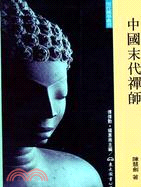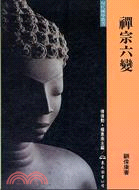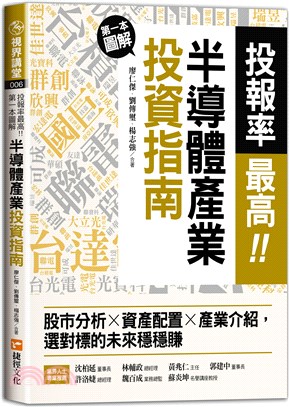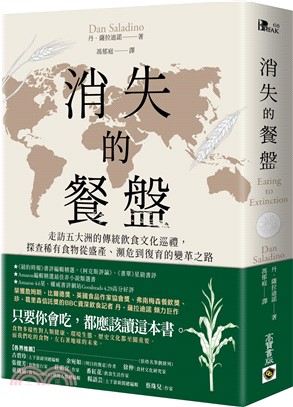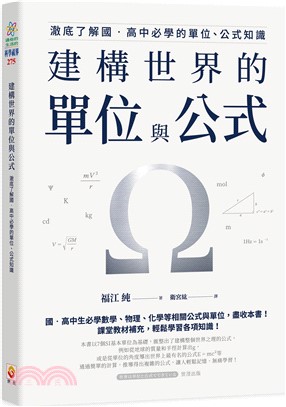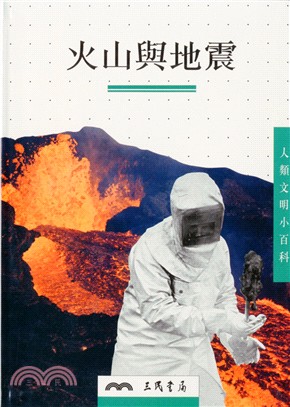陶瓷新型膠態成型工藝(簡體書)
- ISBN13:9787302213246
- 出版社:清華大學出版社(大陸)
- 作者:黃勇; 楊金龍
- 裝訂:精裝
- 出版日:2010/07/01
商品簡介
作者簡介
Jinlong Yang, Born in 1966, graduated fromBeijing Institute of Technology in 1987,graduated and got the master degreefrom North University of China (NUC)in 1990, got the doctor degree fromTsinghua University in 1996. He had thepost-doctoral experience at Departmentof Materials in Swiss Federal Institute of Technology (ETH-Zurich) from 1999to 2000. He became a full professor in Tsinghua University in 2004, and had theposition of special-engaged professor and director of laboratory of advancedceramics in NUC since 2006.Research fields include: structured ceramics, ceramic matrix composites, colloidalforming technology of ceramics and laser green machining of ceramics. He hadwon some top honors, including the second class prize of National TechnologyInvention for a research program by State Council of China, and Science andTechnology Advancement Prize for other three programs awarded by the Ministryof Education and the government of Beijing respectively. He has delivered morethan 100 papers, and got 30 state patents for invention.
目次
1.1 Colloidal Injection Molding
1.1.1 The Concept of CIMC
1.1.2 The Flowchart of CIMC
1.1.3 The Machine of CIMC
1.2 Pressure Induced Forming
1.2.1 Effect of Hydrostatic Pressure on Solidification
1.2.2 Homogeneity of the Green Bodies
1.2.3 Controlling the Inner Stress in the Green Body
1.3 Storage Stability of Ceramic Slurries
1.3.1 The Importance of Storage Stability of Slurry
1.3.2 Chemical Stability
1.3.3 Inhibitor for Slurry Storage
1.4 To Prepare High Reliability Ceramic Parts with Complex Shapes: Aqueous Colloidal Injection Molding
References
Chapter 2 Gel-Tape-Casting of Ceramic Substrates
2.1 Fundamental Principle and Processing of Aqueous Gel-Tape-Casting
2.1.1 Tape Casting Types and the Raw Materials
2.1.2 Polymerization of the Monomer
2.1.3 Influence Factors on Polymerization of the Monomer
2.1.4 Processing of the Gel-Tape-Casting
2.2 The Characteristics of Slurries Used for Aqueous Gel-Tape-Casting
2.2.1 The Properties of the Aqueous Ceramic Slurries with Binder
2.2.2 The Influence of Dispersants on Stability and Rheology of Aqueous Ceramic Slurries with Organic Monomer
2.2.3 The Influence of Plasticizer on Properties of Aqueous Ceramic Slurry with Organic Monomer
2.2.4 The Influence of pH on the Properties of Slurries with Organic Monomer
2.2.5 The Effect of Surfactant on Wetting and Green Tape Releasing (Separating)
2.2.6 Foam and Pore Elimination
2.2.7 Sintering of Green Tape Prepared by Slurry
2.3 Aqueous Gel-Tape-Casting with Styrene-Acrylic Latex Binder
2.3.1 The Importance of Binders in Gel-Tape-Casting Process
2.3.2 The Forming Film Mechanism of Latex Binder
2.3.3 Raheological Properties of the Alumina Slurries with Binder
2.3.4 The Physical Properties and Microstructure of Green Tapes with Latex Binder
2.4 A Gel-Tape-Casting Process Based on Gelation of Sodium Alginate
2.4.1 Why Study on Tape Casting of Sodium Alginate
2.4.2 The Preparation of Aqueous Alumina Suspensions with Sodium Alginate and Calcium Phosphere Tribasic
2.4.3 Control of the Gelation of Sodium Alginate
2.4.4 Characterization of Green Tapes
2.5 The Spray Trigger Fast-Curing for the Gel-Tape-Casting Process
2.5.1 The Idea of the Spray Trigger Fast-Curing
2.5.2 Outline of the New Process
2.6 The Features and Prospects of the Aqueous Tape-Casting
References
Chapter 3 Gelation Forming Process for Low Toxicity System
3.1 Gelation Forming of Ceramic Suspension with Agarose
3.1.1 Characteristics of Agarose
3.1.2 The Effect of Agarose Contents on the Rheology of Aqueous Ceramic Suspensions
3.1.3 The Forming Courses of the Aqueous Ceramic Suspensions with Agarose
3.2 Alumina Casting Based on Gelation of Gelatine
3.2.1 Characteristics of Gelatine
3.2.2 The Gelation Process of the Ceramic Slurry with Gelatine Solution
3.2.3 The Preparation of Green Body Using Slurry with Gelatine Solution
3.3 A Casting Forming for Ceramics by Gelatine and Enzyme Catalysis
3.3.1 Research Background
3.3.2 The Gelation Mechanism of Gelatine Solution with Urea under Enzyme Catalysis
3.3.3 The Rheology and Zeta Potential of Alumina Suspension Containing Gelatine and Urea
3.3.4 The Coagulation Forming and Microstructure of Green Body
3.4 The Alumina Forming Based on Gelation of Sodium Alginate
3.4.1 Research Background
3.4.2 The Gelation Principle of Sodium Alginate
3.4.3 The Preparation Process of Alumina Green Bodies and Samples by Sodium Alginate
3.5 The Gel-Casting of SiC Based on Gelation of Sodium Alginate
3.5.1 Introduction of the Research
3.5.2 The Effect of Dispersant on the Colloidal Behaviors of the SiC Suspension
3.5.3 The Rheological Property of SiC Suspension
3.5.4 The Sedimentation Behavior of the SiC Suspension
3.5.5 The Gelation Principle and Process of the Alginate Solution
3.5.6 The Gelation of the SiC Suspension with Alginate
3.6 The Alumina Gel-Casting with a Low-Toxicity System of HEMA
3.6.1 The Academic Idea and Research Program
3.6.2 The Colloidal Chemistry and Rheological Property
3.6.3 The Binder Burnout and Application of the New System
3.7 The Synergistic Low-Toxicity Gel-Casting System by Using HEMA and PVP
3.7.1 The Academic Idea and Research Program
3.7.2 Zeta Potentials and Rheological Properties
3.7.3 The Activation Energy and Solidification
3.7.4 The Green Strengths and Microstructures
3.7.5 The Exfoliation Elimination Effect and Analysis of the Interaction between PVP and HEMA Molecules
References
Chapter 4 Generation, Development, Inheritance, and Control of the Defects during the Transformation from Suspension to Green Body
4.1 The Rheological Behaviors of Aqueous Ceramic Suspensions
4.1.1 The R.heological Behaviors of Aqueous Alumina Suspensions
4.1.2 The Effect of Rheological Properties of Suspension on Mechanical Strength of Ceramics
4.1.3 The Effect of Solid Loading on Colloidal Forming
4.2 The Generation and Development of Defects
4.2.1 The Generation Mechanisms of Agglomerations in Ceramic Suspensions
4.2.2 The Influences of Idle Time on Microstructures and Mechanical Properties of Green Bodies by Direct Coagulation Casting
4.3 The Effect of Ionic Conductance on Preparation of Highly Concentrated Suspension
4.3.1 The Academic Idea and Research Program
4.3.2 The Relationship Between Ion Conductivity Constants and Solid Loading
4.4 Control of Inner Stress in Green Body
4.4.1 Origin, Transformation and Control of Inner Stress in Green Body
4.4.2 The Release and Control of Inner Stresses in Ceramic Green Body
4.5 The Suppression of Surface-Exfoliation with the Addition of Organic Agents
4.5.1 The Suppression of Surface-Exfoliation by Introducing PAM into Monomer System in Suspension
4.5.2 The Suppression of Surface-Exfoliation by Introducing Polyethylene Glycol into Monomer System in Suspension
4.5.3 The Suppression of Surface-Exfoliation by Introducing Poly-vinylpyrrolidone (PVP) into Monomer System in Suspension
References
Chapter 5 The Gel-Casting of Non-Oxide Ceramics
5.1 The Effects of Powder Surface Modification on Concentrated Suspensions Properties of Si3N4
5.1.1 The Contributing Factor and Elimination of Macropores in Si3N4 Green Bodies
5.1.2 The Effect of Foreign Ions on Concentrated Suspension of Si3N4
5.1.3 The Effect of Acid Cleaning and Calcinations on the Suspension Properties of Si3N4
5.1.4 The Effect of Liquid Medium and Surface Group on Dispersibility of Si3N4 Powder
5.2 The Gel-Casting of Si3N4 Ceramics
5.2.1 The Preparation of Si3N4 Ceramics with Surface-Coated Si3N4 Powder
5.2.2 The Preparation of Si3N4 Ceramics with Surface-Oxidized Si3N4 Powder
……
Chapter 6 Application of New Colloidal Forming
Chapter 7 The New Methods and Techniques Based on Gel-Casting
Appendix
Index of Terms
Index of Scholars
Postscript
主題書展
更多主題書展
更多書展本週66折
您曾經瀏覽過的商品
購物須知
大陸出版品因裝訂品質及貨運條件與台灣出版品落差甚大,除封面破損、內頁脫落等較嚴重的狀態,其餘商品將正常出貨。
特別提醒:部分書籍附贈之內容(如音頻mp3或影片dvd等)已無實體光碟提供,需以QR CODE 連結至當地網站註冊“並通過驗證程序”,方可下載使用。
無現貨庫存之簡體書,將向海外調貨:
海外有庫存之書籍,等候約45個工作天;
海外無庫存之書籍,平均作業時間約60個工作天,然不保證確定可調到貨,尚請見諒。
為了保護您的權益,「三民網路書店」提供會員七日商品鑑賞期(收到商品為起始日)。
若要辦理退貨,請在商品鑑賞期內寄回,且商品必須是全新狀態與完整包裝(商品、附件、發票、隨貨贈品等)否則恕不接受退貨。















